Saudi Arabia has announced several ambitious plans to launch a wave of megaprojects that are set to transform the country into a global economic powerhouse, as reported by Arabian Business.
With investment totaling billions of dollars, the kingdom is embarking on a journey to diversify its economy away from oil, create jobs, and boost its international standing as a leading hub for trade and tourism.
That being said, here is a look at 15 upcoming megaprojects set to transform the nation:
1. AlUla
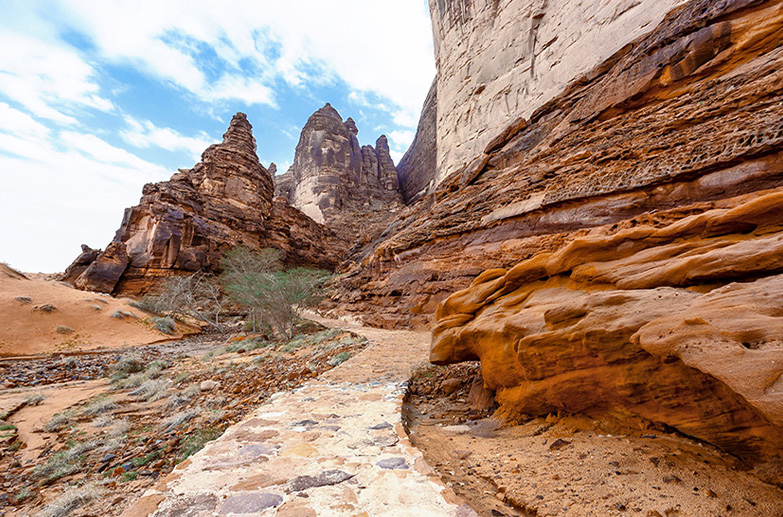
Aheritage site with over 200,000 years of history, Saudi Arabia’s AlUla is home to some of the world’s ancient cultural sites, sandstone mountains and oases.
However, the kingdom is currently is on the process of transforming the historic site into an international destination through the ‘Journey through Time’ masterplan – led by Saudi Arabia’s Crown Prince Mohammed bin Salman.
The masterplan has made it more accessible for tourists to visit the site.
On completion, it will add to the Royal Commission for AlUla’s (RCU) goals of contributing at least $32 billion to the national GDP, opening 38,000 jobs by 2035.
“The masterplan directly contributes to the realisation of Vision 2030 by reinvigorating AlUla as a tourism destination and catalysing economic diversification in the region. Improving quality of life for residents, boosting employment opportunities, and accelerating the development of the region’s cultural and tourism infrastructure is built into the plan,” RCU said in a statement.
AlUla will also see five districts that span the historic area – AlUla Old Town, Dadan, Jabal Ikmah, Nabataean Horizon and Hegra Historical City.
The districts will be traversed by AlUla’s ancient oasis, with a nine-kilometre section at the heart of the Cultural Oasis being fully rejuvenated.
The historical site will also see 15 new cultural areas which include museums, galleries and cultural centres.
AlUla will also feature the Wadi of Hospitality, which connects the five districts by a 20-kilometre-long public realm.
Otherwise, the 22,500 square kilometre heritage site will also feature a 46-kilometre low-carbon tram line connecting the site to AlUla International Airport. Visitors can also travel by car or, if they prefer another immersive option, on foot, by bicycle, or even on horseback.
Moreover, the heritage site will add a total of 5,000 additional room keys to the overall target of 9,400 keys by 2035, with each district offering visitors a variety of living and hospitality options, ranging from hotels and eco-tourism resorts to luxury lodges and canyon farms that are carved into the sandstone rocks.
Recently, the kingdom’s AlUla Development Company formally launched operations as the kingdom transforms the AlUla project into a global tourism destination.
AlUla is one of the world’s largest and oldest cultural sites located in the kingdom, and the new firm is backed by the kingdom’s Public Investment Fund (PIF).
2. AMAALA
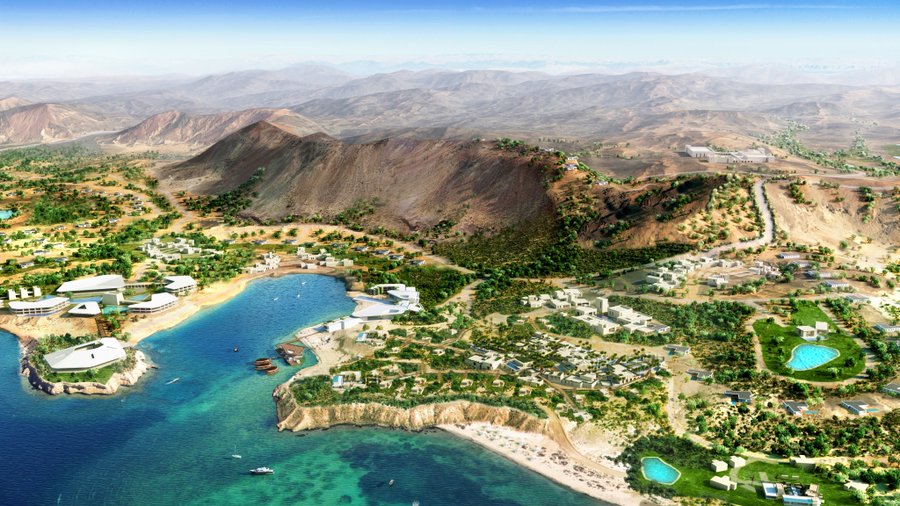
AMAALA, is an upcoming grand project that is set to redefine sustainable development, has been incorporated as a standalone company. AMAALA merged with the Red Sea Development Company to form Red Sea Global (RSG).
“We are not only expanding our footprint to help create massive economic opportunities – valued at hundreds of billions worth of riyals – for the people of Saudi Arabia. We also want to set new global standards in development and inspire the industry to do better,” John Pagano, the chief executive of Red Sea Global (RSG) said.
The Public Investment Fund (PIF) giga-project, located in northwest Saudi Arabia along the Red Sea, will offer a vibrant and progressive destination for recreation, wellness, and the celebration of the region’s rich cultural heritage.
Spanning across 3,800-square kilometers, AMAALA will form the heart of the Middle Eastern Riviera and is expected to become a leading hospitality destination on the global map.
The project will feature 14 of the world’s top hotel brands, more than 800 residential villas, apartments, and estate homes, 200 high-end fashion establishments, an arts academy, and a wide range of galleries, ateliers, and artisan workshops.
The development will also include signature dining experiences, world-class marinas, yacht clubs and sporting venues.
In addition, AMAALA will also feature a “mirage-inspired” airport designed by UK-based architectural and design firm Foster + Partners.
“The structure takes its inspiration from the surrounding environment, resulting in a mesmerising mirage effect. A spacious courtyard will anchor the terminal and will be complemented by contemporary interiors complete with unique artwork and tailored experiences. The airport will reflect AMAALA’s ultra-luxury hospitality spirit, providing an exclusive private-club experience perfectly encapsulating AMAALA’s pillars of art and culture; wellness and sport; and sea, sun, and lifestyle,” AMAALA said in a statement.
AMAALA will blend wellness with creative and social offerings to provide guests with a holistic journey of self-transformation.
The project is situated within the Prince Mohammed bin Salman Natural Reserve, a hidden, untouched, and thriving stretch of the Red Sea. The reserve’s beauty and natural resources will be preserved while providing an exceptional destination for guests.
The incorporation of AMAALA as a standalone company is a significant step towards the realization of this grand project.
It will operate independently with its own board of directors, enabling it to implement its strategies and plans efficiently.
The project’s focus on sustainable development and preserving the natural environment is a testament to the kingdom’s commitment to achieving the United Nations’ Sustainable Development Goals.
AMAALA is poised to become a world-class destination and an icon for sustainable development in the Middle East.
With its focus on wellness, creativity, and social offerings, it will undoubtedly be a significant attraction for tourists and a source of pride for Saudi Arabia.
3. Red Sea Project
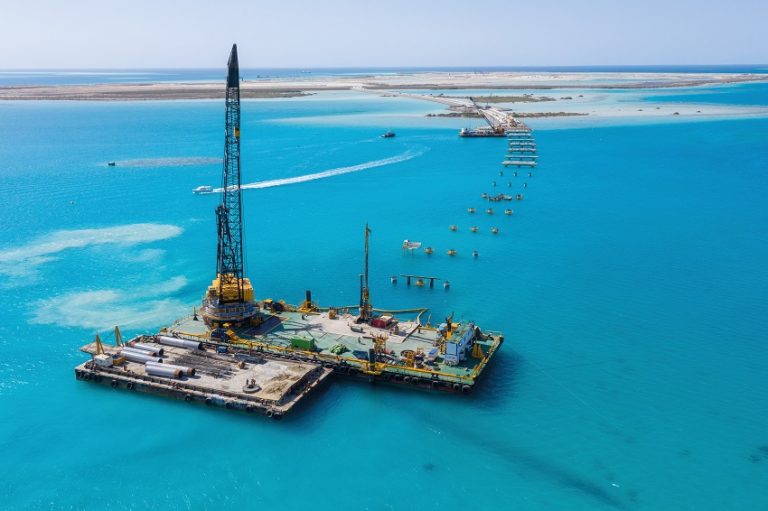
A new luxury resort is set to become a major attraction for tourists visiting the Middle East.
The Red Sea Project, located between the coastal cities of Umluj and Al Wajh, will span an impressive 30,000 square kilometres and will comprise a natural archipelago of pristine islands, a vast desert landscape, mountain peaks, and archaeological treasures.
The region boasts 200km of untouched coastline and is set to become one of the world’s most successful sustainable tourist resorts.
Designed with a strong focus on heritage, culture, and conservation, the Red Sea Project is being built to attract visitors all year round.
The resort will provide 8,000 new hotel rooms once completed and will be the first fully integrated, luxury, mixed-use resort in the region.
The developers of the Red Sea Project are determined to make it a model for sustainable tourism.
A zero waste-to-landfill-policy, 100 percent carbon neutrality, and a ban on single-use plastics are some of the steps being taken to achieve this goal.
In addition to its impressive sustainability credentials, the Red Sea Project offers visitors a unique experience that combines the natural beauty of the region with its rich cultural heritage.
The resort is set to become a must-see destination for those interested in exploring the historical and archaeological treasures that dot the vast desert landscape.
The Red Sea Project is scheduled for completion by 2030 and is expected to attract visitors from all over the world.
With its focus on heritage, culture, and sustainability, the resort is poised to become one of the most exciting developments in the Middle East, offering a truly unique and unforgettable experience for visitors.
4. Diriyah
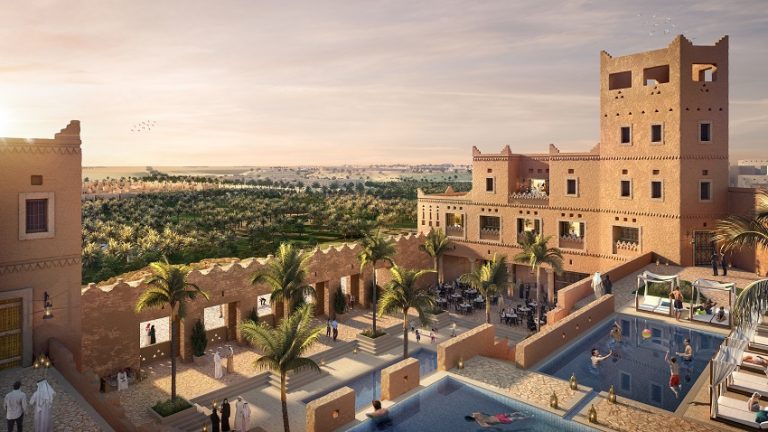
Saudi Arabia’s historic city of Diriyah has been renewed as the country’s cultural capital, with ambitious plans to transform it into one of the world’s foremost lifestyle destinations for culture and heritage, hospitality, retail, and education.
Located just 20 minutes northwest of Riyadh’s city center, Diriyah will showcase over 300 years of authentic culture and history, delivering inspiring heritage experiences, educational and cultural opportunities, world-class residential living, and outstanding lifestyle offerings.
At the heart of the development is the At-Turaif UNESCO World Heritage Site, which is an iconic mud-brick city and the home of the First House of the Al Saud family, preserved and restored for future generations.
The project, under the mandate of Diriyah Gate Development Authority and as one of the Public Investment Fund’s projects, supports Vision 2030 by targeting 27 million local and international visitors by 2030.
This contributes to the national tourism strategy, which aims to host 100 million worldwide tourists in the Kingdom by 2030.
Combining traditional Najdi architectural typology and new urbanism, Diriyah is designed to emotionally connect with visitors and residents while promoting and celebrating the destination’s rich heritage.
It aims to reveal the origins of modern Saudi Arabia and the spiritual values in which it is rooted.
The development offers a range of lifestyle experiences, including shopping, entertainment, and dining. It also includes world-class residential living, providing residents with an exceptional quality of life.
Diriyah will become one of the world’s great gathering places, offering a one-of-a-kind destination that celebrates Saudi Arabia’s unique culture and history by 2030.
5. King Salman Energy Park
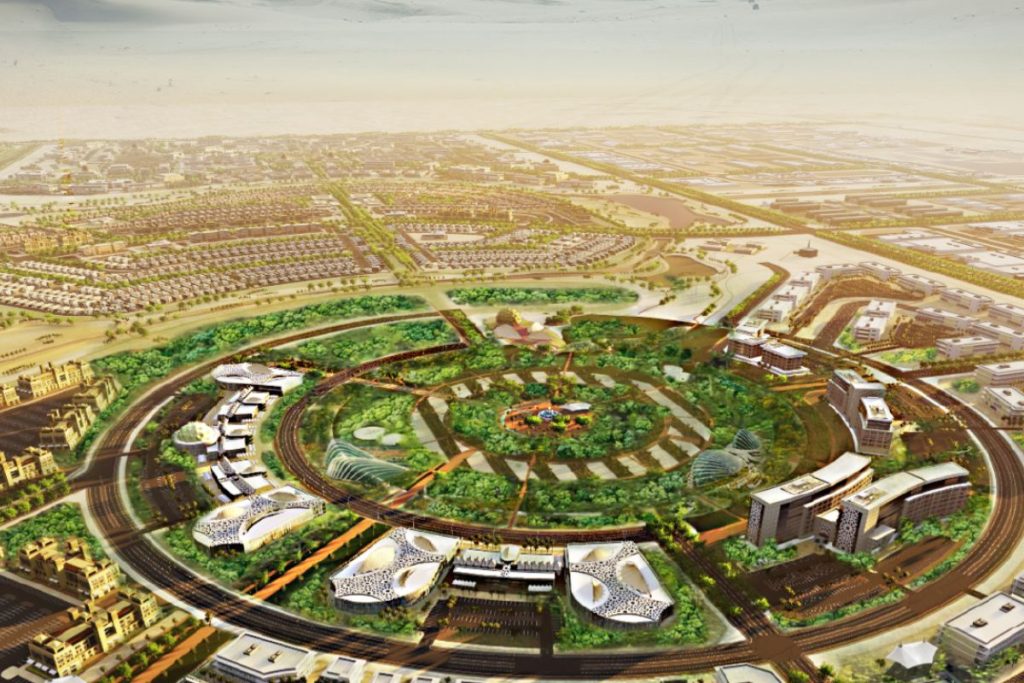
Known as SPARK, the King Salman Energy Park, is a brand-new industrial ecosystem being developed as a hub for the global energy market.
With the region’s reputation for oil and gas resources and a high demand for energy goods and services, SPARK is in the perfect position to offer unparalleled access to growth opportunities, world-class support services, and supply chain efficiencies.
SPARK’s strategic location is what sets it apart, providing tenants and investors with a gateway to access energy players across the world, not just locally but throughout the wider Gulf region as well.
Additionally, with easy access to King Fahd International Airport, King Abdul-Aziz Seaport, and the GCC highway, tenants and investors are sure to enjoy maximum convenience.
SPARK’s development is in line with the Saudi Arabia Vision 2030 plan, which aims to diversify the Kingdom’s revenue streams by building a strong economy.
This ambitious project is set to contribute over $6 billion to the country’s GDP annually and create up to 100,000 jobs in the long run.
SPARK’s vision is to be a leading industrial ecosystem with sustainability at its core, serving as a platform for the energy sector.
By providing world-class infrastructure and services, SPARK aims to help investors grow their businesses, while also bringing sustained value to the communities it serves.
As SPARK prepares for its grand opening, energy sector players are encouraged to take advantage of this exceptional opportunity to expand their businesses and take advantage of the many benefits SPARK has to offer.
From its excellent location to its top-notch support services, SPARK is set to become a 21st-century platform for the energy sector, fostering excellence and innovation, and propelling the industry into a bright future.
6. King Salman Park
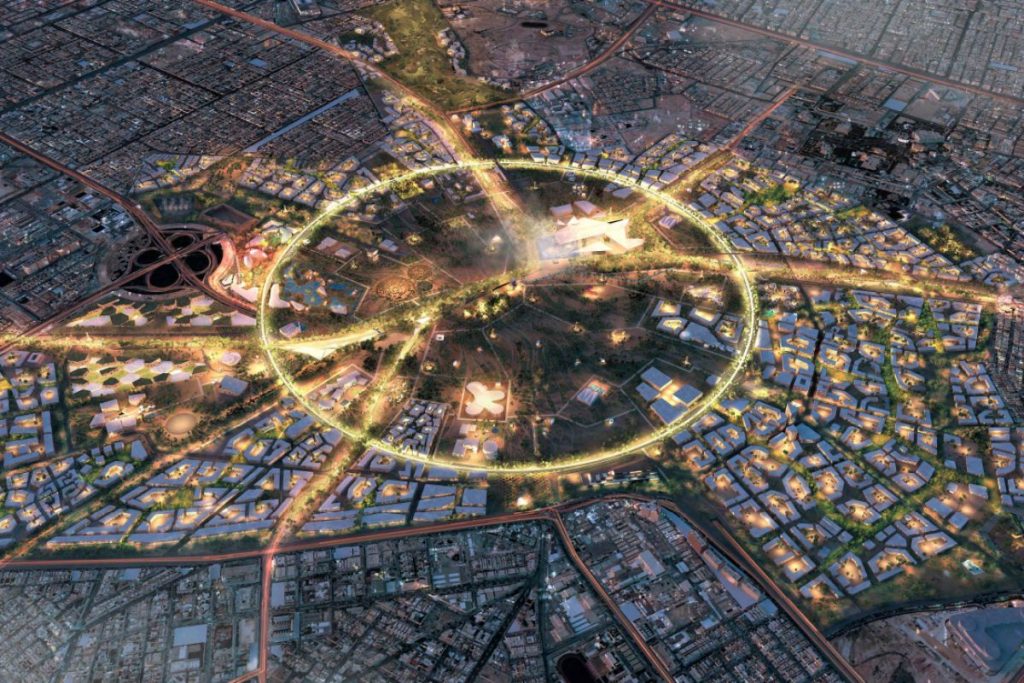
King Salman Park, is proposed to be the largest urban park in the world, and was launched by the Custodian of the Two Holy Mosques, King Salman Bin Abdulaziz, on March 19, 2019.
The park, which is set to be located in Riyadh, Saudi Arabia, covers more than 16km², is part of the Saudi Vision 2030 initiative aimed at improving the quality of life in the city.
The park will offer a wide range of cultural, artistic, recreational and sports options, making it a hub for residents and visitors alike.
It will feature vast open green spaces, including an Islamic-style garden, vertical gardens, a maze garden, and a bird and butterfly sanctuary.
The park also includes a 7.2km circular pedestrian walkway, a valley area surrounded by art and water features, and various water features covering over 300,000 square meters.
The Royal Arts Complex, one of the park’s main attractions, occupies an area of over 400,000 square meters and includes a national theater with a seating capacity of 2,500, 5 museums of different sizes, an outdoor theater with a capacity of 8,000, and a complex with 3 cinema halls, 4 art academies, and an educational center for children.
The park also includes 7 different museums, plazas to host different events, artworks, and landmarks.
Other features of the park include a royal golf course covering an area of 850,000 square meters, a sports complex over an area of 50,000 square meters, a virtual reality court, a sky diving center, an equestrian center, running and biking routes, a 100,000 square meter amusement park, a 140,000 square meter aquapark, a family amusement center, a tower and a skybridge. The park also has an environmental, cultural, and educational center covering 80,000 square meters.
The park will be easily accessible through several main roads and is linked to the King Abdulaziz Public Transport Project through five stations on the Green Line of Riyadh Metro, and 10 stations of Riyadh Bus network.
The park will also include residential compounds providing 12,000 housing units, 16 hotels with a total of 2,300 rooms, 500,000 square meters of retail spaces, mosques, police, healthcare, educational, and social facilities, public libraries, 280,000 square meters of parking spaces, main and service roads, and walkways and pathways
King Salman Park is a significant step towards achieving the goals of Saudi Vision 2030, as it enhances the quality of life for the people of Riyadh and raises the city’s global ranking.
7. THE LINE
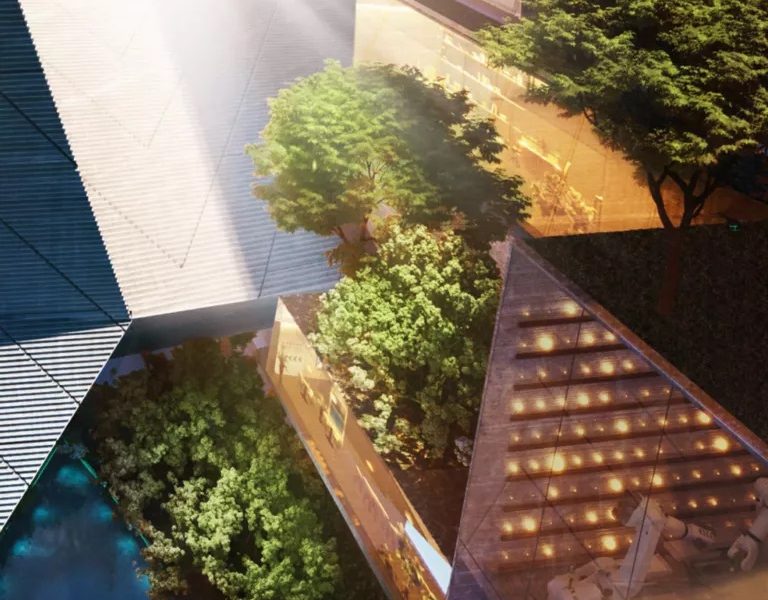
Saudi Arabia’s The Line at NEOM, is an upcoming futuristic linear city, which will be built using “a lot of artificial intelligence to design through a digital twin backbone,” NEOM’s executive director Giles Pendleton said in an internal interview.
The project is part of the $500 billion NEOM project, a futuristic city with a mixed-use development, containing spaces for work, play and living.
“We’ve got to build quite a lot of real estate in a short space of time. Well, we’re not actually building THE LINE. We’re assembling it from a series of modular pieces that are pre-engineered and predetermined as to what they do,” Pendleton said when asked about building a new city of nine million inhabitants in a short period of time.
The linear city, which is being built in the kingdom’s north-west Tabuk province, recently saw excavators digging a wide trench in the desert.
The Line’s mirror facade will allow the city to seamlessly blend into the nature around it. With a reduced infrastructure footprint, the linear city will have no roads, cars or emissions, running on 100 percent renewable energy with 95 percent of land preserved for nature. The city is built to prioritise health and well-being over transportation and infrastructure.
The city will be just 200 metres wide but 170 kilometres long and 500 meters above sea level with ideal climate throughout the year and a high-speed rail offering residents end-to-end transit in 20 minutes.
Pendleton also revealed that The Line will have a “one door-lock system.”
“But, if we need 100 million of them, then it’s easier for us to set up a factory and create exactly the same block 100 million times. We will create a very simple process with optimised, standardised and industrialised production whereby things are made in factories in large-scale volumes within NEOM – so that we don’t have to transport them far. Think of it like a giant assembly kit. The great thing about pre-engineered parts is that you can control quality and you can control dimensions, so that things connect.”
Saudi Crown Prince Mohammed bin Salman said “The Line” will embody “Zero Gravity Urbanism,” where city functions are layered vertically.
“The designs revealed today for the city’s vertically layered communities will challenge the traditional flat, horizontal cities and create a model for nature preservation and enhanced human livability,” he said in a statement.
The crown prince said The Line “will tackle the challenges facing humanity in urban life today and will shine a light on alternative ways to live,” adding that residents will be able to reach all daily needs within a five-minute walk in “The Line,” where public parks and pedestrian areas, schools, homes and places for work are “layered.”
There will also reportedly be a high-speed rail with an end-to-end transit of 20 minutes.
8. TROJENA
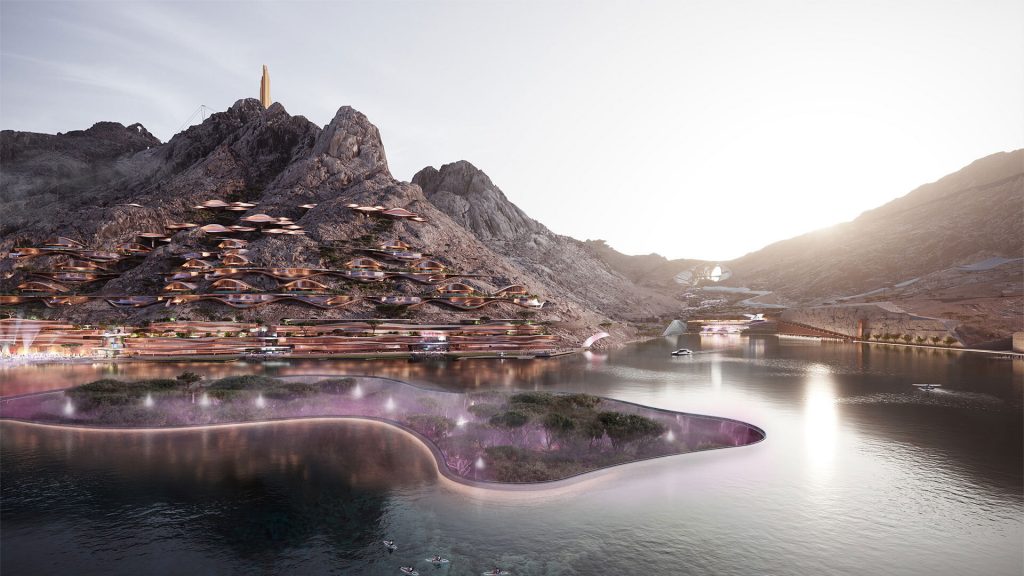
Located 50 kilometres from the Gulf of Aqaba coast, lies Saudi Arabia’s TROJENA – a snow-capped tourist destination, and part of the kingdom’s megaproject NEOM.
With elevations ranging from 1,500 metres to 2,600 metres, covering an area of nearly 60 square kilometres, the destination is set to be transformed ahead of the 2029 Asian Winter Games. Saudi Arabia is the first country in the Middle East to host the games, which will feature 32 participating nations.
“This achievement sheds light on the enormous potential and the outstanding infrastructure of Saudi Arabia to host and organise international-level sports competitions and games successfully,” the country’s president of the Saudi Olympic and Paralympic Committee, Prince Abdulaziz bin Turki Al-Faisal said after the announcement that TROJENA would host the event.
The kingdom’s bid to host the games was “unanimously approved” at the general assembly meeting in Phnom Penh, Cambodia last week.
TROJENA, which is due for completion in 2026, is also located at an area where winter temperatures dip below zero. Year-round temperatures in the region average around 10 degrees cooler than other parts of Saudi Arabia.
The project was launched as part of NEOM’s “plan and strategy to contribute to supporting and developing the tourism sector in the region,” NEOM said in a statement.
“TROJENA will redefine mountain tourism for the world by creating a place based on the principles of ecotourism, highlighting our efforts to preserve nature and enhance the community’s quality of life, which is aligned with the goals of the kingdom’s Vision 2030,” Saudi Crown Prince, Prime Minister and Chairman of NEOM company board of directors, Mohammed bin Salman said during the project’s launch.
The Crown Prince explained that the project falls in line with the Saudi Arabia’s commitment to “be part of the global effort to protect the environment.”
He added: “TROJENA will be an important addition to tourism in the region, a unique example of how Saudi Arabia is creating destinations based on its geographical and environmental diversity. This forward-looking vision will ensure that mountain tourism will be another revenue stream to support the kingdom’s economic diversification while still preserving its natural resources for future generations.”
The destination will house six districts, with each of them having tailored experiences to ensure visitors visit the upcoming region all year long. The districts are: Gateway, Discover, Valley, Explore, Relax and Fun.
Additionally, the destination has a planned set of programmes for visitors to experience throughout different times of the years.
From September to November, visitors can access a wellness summit, alternative medicine, discovery week, yoga retreat, artist residency and entertainment residency.
From December to March, which is the winter season, visitors can look forward to skiing, snowboarding, winter fashion week, ice skating, music festival and a film festival.
For adventure season, which runs from March to May, visitors and residents at TROJENA can opt for a high-altitude training, witness an adventure triathlon, take part in a yoga retreat, go mountain biking, paragliding and even climbing.
During Lake Season, which runs from May to September, visitors can visit a music festival, food festival, art fair, cultural week, light show, and attend a yoga retreat.
Other key highlights at TROJENA include: a ski village, the vault, the lake, the wildlife reserve, the observatory, the bow and the ultra-luxury mansions.
“Outdoor skiing is a unique feature of TROJENA that will provide a unique experience never before witnessed in the region, especially in Gulf countries known for their desert climates,” NEOM said earlier this year, adding that amateurs and professionals alike will be able to “enjoy the many ski runs of various difficulties with an array of contrasting and breath-taking views.”
The coldest place in the kingdom, will also feature ‘The Bow’ hotel, which is “an architectural masterpiece that will offer an unrivalled hotel experience.”
In terms of residences, the snowy development will also include the Slope Residences.
“These will be located near the ski slope overlooking the lake, designed to blend in with the surrounding landscape, as well as luxurious mansions with panoramic views designed to reflect the beauty of the environment,” NEOM said.
TROJENA expects to attract 700,000 visitors and 7,000 permanent residents to live in the development and its adjacent residential districts by 2030.
“All construction activity will adhere to NEOM’s strict environmental principles, which include a commitment to minimize disruption to the local ecology and to ensure long-term sustainability,” the statement said.
In line with Saudi Arabia’s Vision 2030 goals, TROJENA aims to create over 10,000 jobs and add SAR 3 billion ($800 million) to the kingdom’s GDP by 2030.
9. OXAGON
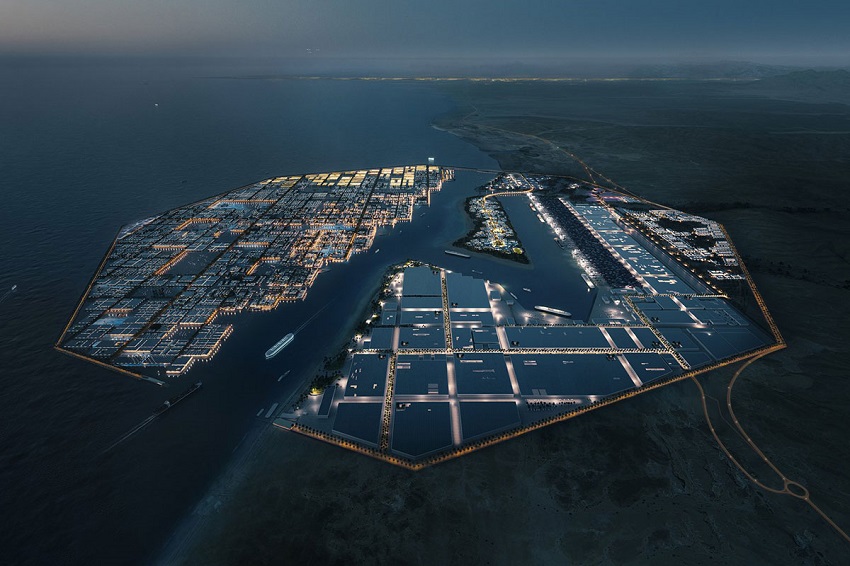
Saudi Arabia’s NEOM is building a floating city, Oxagon, in the Red Sea, near the Suez Canal.
The city is designed to revolutionise global manufacturing by creating a new logistics centre that will redefine the world’s approach to industrial development.
The city’s unique shape reflects its name, and it will mainly comprise factories, manufacturing facilities, and logistics-related sites, though it will also house around 90,000 residents by 2030.
The city will be one of the world’s most technologically advanced logistics hubs, with state-of-the-art integrated port and airport connectivity.
It will focus on seven sectors: sustainable energy; autonomous mobility; water innovation; sustainable food production; health and well-being; technology and digital manufacturing; and modern methods of construction.
The city is planned around the Kingdom’s net-zero goals and will feature the world’s first fully integrated port and supply chain ecosystem.
OXAGON already has confirmed tenants, including Air Products, ACWA Power, and NEOM’s hydrogen project, Gulf Modular International, Hyzon Motors, and Desert Technologies.
Oxagon will also include residential communities that are integrated with nature, and most of the communities will be waterfront.
They will be cooled and controlled using the ocean’s natural moderating effects, and they will be resilient to sea-level rise. People can commute via hydrogen-powered modes of transportation or walk to their destinations.
Oxagon will also feature an innovation campus that will rival established global centers. It will create a collaborative environment built around research and innovation to create a truly circular economy.
The city’s full completion is expected by 2030, and some of its key features, including advanced logistics solutions facilities, are expected to take shape by 2025.
10. SINDALAH
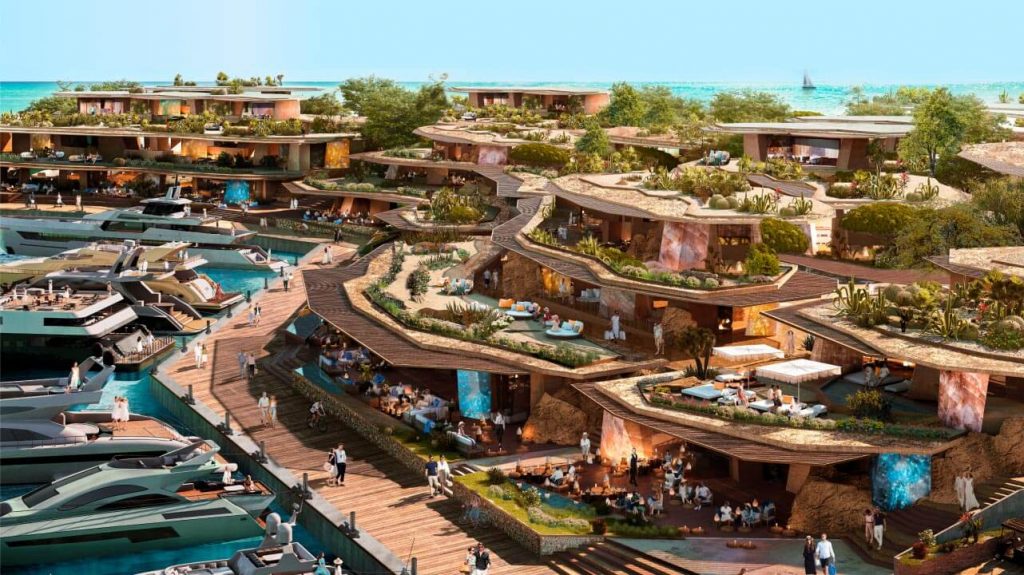
Saudi Arabia’s NEOM is set to open Sindalah, an island off the coast of the development, in 2024, the kingdom’s crown prince Mohammed bin Salman announced.
Covering an area of approximately 840,000 square metres, Sindalah is a group of islands that will be developed in the giga-project. It is expected to create 3,500 jobs for the tourism sector and hospitality and leisure services.
According to the Saudi Press Agency (SPA), the island will act as a main gateway to the Red Sea, offering visitors customised nautical experiences and is expected to start welcoming guests from early 2024.
The luxury island will also be home to a yacht club, three luxury resorts, a spa, over 50 luxury brands and 86 piers.
“This is another significant moment for NEOM and a major step in the Kingdom realizing its tourism ambitions under Vision 2030,” the crown prince said, adding that “Sindalah will be NEOM’s first luxury island and yacht club destination in the Red Sea, providing a scenic gateway to the Red Sea that will become the region’s most exciting and attractive tourism location.
He added: “It will be a destination where travelers can experience the true beauty of NEOM and Saudi Arabia, above and below the water, making Sindalah the future of luxury travel.”
The island aims to attract over 2,400 visitors per day by 2028.
“Like The LINE, our aim is to achieve a five-minute walk to all the important services and amenities that people need. There will be no roads or cars. The public realm approach will be about enabling social interaction, inspirational views and amazing experiences – all supported by advanced technology. Interestingly, the island is in the shape of a seahorse, and that’s a great metaphor, because like that creature, the island is superbly unique and different,” NEOM chief urban planning officer Antoni Vives said in an internal interview.
Vives added: “Sindalah is a new frontier for leisure, exploration and self-fulfillment. We want to provide new and improved experiences in this world – with sustainability, connectivity and joy in mind. If we achieve this, anything beyond that would be added value.”
11. Qiddiya
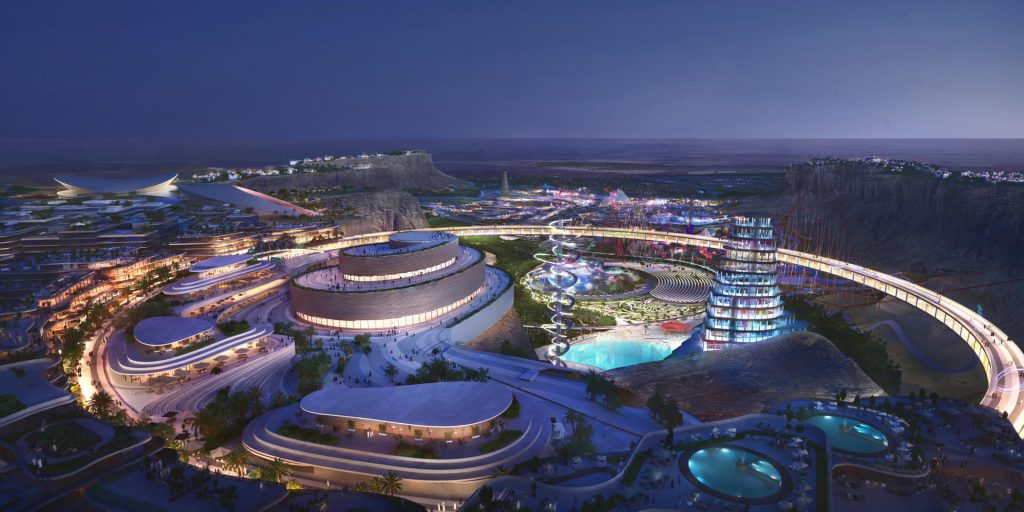
Qiddiya, a groundbreaking new development in the Kingdom of Saudi Arabia, is set to revolutionize the entertainment, sports, and arts industries.
Launched by the kingdom’s Crown Prince Mohammed bin Salman and part of the Saudi Vision 2030 plan, Qiddiya will help diversify the country’s economy, create new job opportunities, and empower its youth and female population.
The ambitious project, located on the outskirts of Riyadh, will offer a wide range of experiences based on five cornerstones: Sports & Wellness, Nature & Environment, Parks & Attractions, Motion & Mobility, and Arts & Culture.
From family-friendly theme parks and sports arenas suitable for international competitions to academies for sports and the arts, concert and entertainment venues, and racetracks for motorsport enthusiasts, Qiddiya will cater to visitors of all ages and interests.
The development’s recent groundbreaking ceremony, led by King Salman bin Abdulaziz Al Saud, showcased the vision and magnitude of the project.
With highlights including a performance by Ayed Yousef, a rising Saudi star, and a three-act show examining Saudi Arabia’s past, present, and future, the ceremony culminated in a spectacular fireworks display over the Tuwaiq mountain cliff.
Qiddiya’s Master Plan, revealed in 2019, and its Visitor Experience Center, opened the same year, offer glimpses into the future of the project.
In the design and construction phase, Qiddiya is currently offering numerous opportunities for investors, contractors, suppliers, and infrastructure partners, as well as healthcare providers.
With Qiddiya’s innovative offerings and commitment to advancing the potential of Saudi Arabia’s youth, it is poised to become a leading global destination. The project’s impact is already being felt locally and internationally, with its development being followed by media outlets worldwide.
As Qiddiya continues to take shape, it represents a bold new era for Saudi Arabia’s economy, society, and culture. As the world awaits its completion, it is clear that the project’s impact will be felt far beyond the borders of the Kingdom.
12. Riyadh Sports Boulevard
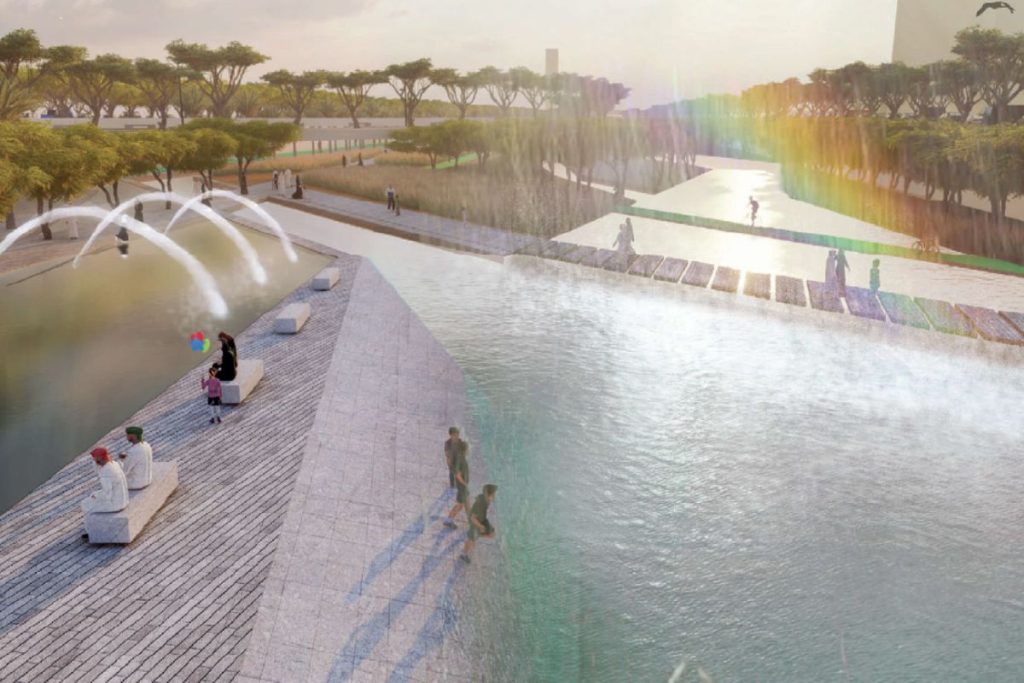
The Saudi Vision 2030 initiative, launched by the Custodian of the Two Holy Mosques King Salman Bin Abdulaziz in 2019, aims to put Saudi Arabia on the map as one of the top 100 cities in the world.
The Sports Boulevard, one of Riyadh’s ambitious projects, will play a crucial role in realizing this vision.
The Sports Boulevard is a 135-kilometre stretch of land that runs through Riyadh, connecting Hanifah valley in the West to Al Salai Valley in the East.
The Boulevard is designed to promote healthy living through sports and exercise, and encourages Riyadh’s residents to walk, cycle, and ride horses.
The project provides 4.2 million square meters of open space, including a desert park that covers 20 square kilometers.
The park features event venues, outdoor museums, and movie theaters, along with areas designated for recreational and commercial activities. The project also includes investment zones, landmarks, and public art installations that will enrich the cultural lifestyle of the city.
The Boulevard is divided into seven main zones, each with a unique offering.
The Hanifah Valley Zone will cater to cyclists, while the Arts District will feature cultural and art facilities.
The Urban Wadi Zone will run alongside the Al Aysen Valley and have a water canal.
The Entertainment District will have a viaduct for professional cyclists and a movie theater.
The Athletics District, which will feature 60 sports sites, will be connected to Princess Nora bint Abdul Rahman University.
The Environmental Zone will run along the Al Sulai valley and promote environmental sustainability.
Finally, the Al Sulai Valley Zone will cater to cyclists and horse riders and feature picnic and camping areas.
The Sports Boulevard project is aligned with the goals of Saudi Vision 2030, and it will create a rich cultural, environmental, and recreational ambiance.
The project will help the citizens of Riyadh to follow a healthy lifestyle and participate in various sports and activities, while also attracting investors and contributing to the growth of the city.
13. Riyadh Metro
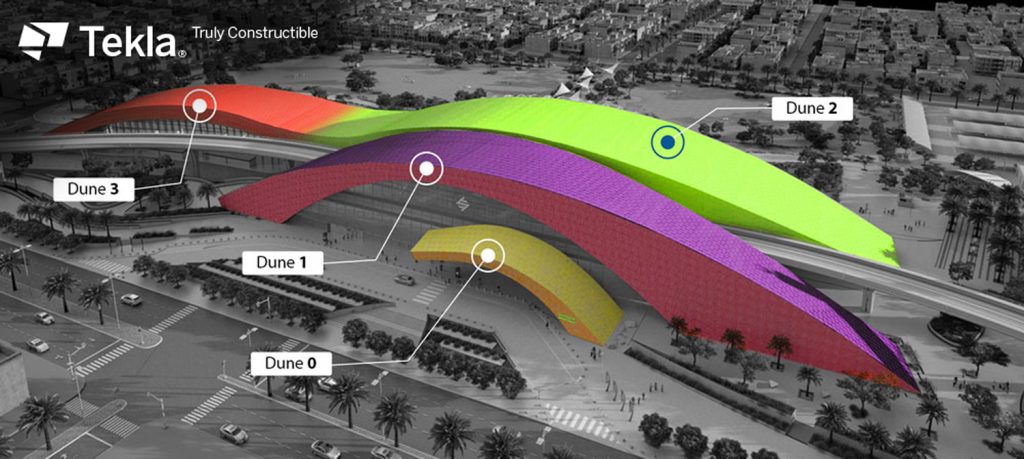
The largest public transport network projects in the world, the Riyadh Metro project features a length of approximately “176 kilometres of railway lines, on which electric trains operate without drivers, in addition to that 40 percent of the train route will be underground, which allows the continuation of the transportation movement in its natural form,” according to a report by Rai Al Youm, which cited the German News Agency (DPA).
Riyadh metro is the largest Single-phase public transport project ever developed.
Saudi Arabia’s Riyadh Metro, which will be the largest project for public transport networks in the world, “will be opened soon,” the report said.
The announcement was reportedly made by Fahd Al-Rasheed, the chief executive officer of the Royal Commission for Riyadh City.
Al-Rasheed, in a statement to DPA, said that the King Abdulaziz Public Transport Project will open “its first phase at the beginning of this year, to be followed by other phases at close intervals.”
The first phase of Riyadh Metro is reportedly expected to start in March, whereas the final operation will take place before the year ends.
The Riyadh Metro project is valued at a whopping $22.5 billion, the report said, citing an official statement.
14. Red Sea International Airport
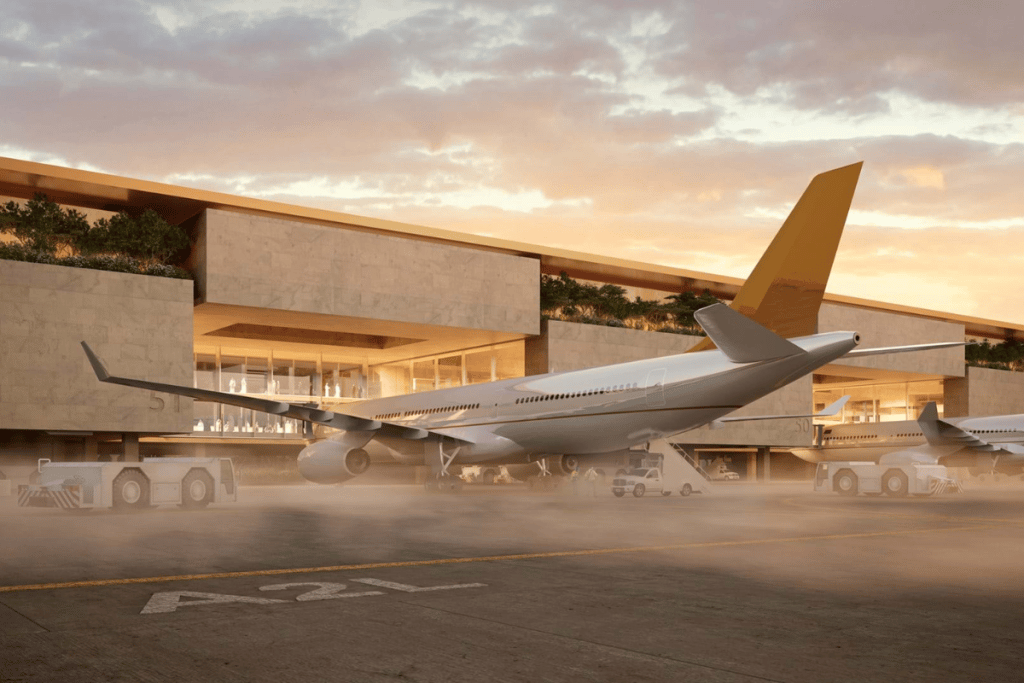
Saudi Arabia will soon be home to one of the largest airports – King Salman International Airport – the kingdom’s Crown Prince Mohammed bin Salman bin Abdulaziz, Prime Minister and Chairman of the Council of Economic and Development Affairs (CEDA), Chairman of the Public Investment Fund (PIF) announced on Monday.
The announcement is in line with PIF’s strategy to diversify Saudi Arabia’s economy away from oil, and is also in line with the National Transport Strategy and the Global Supply Chain Resilience Initiative.
The airport’s construction is led by architects Foster + Partners, which “reimagines the traditional terminal as a single concourse loop, served by multiple entrances. The terminal is very much of its place and connects passengers to the sensory experiences of the city, with natural elements, tempered light and state-of-the-art facilities,” the architecture studio’s head Luke Fox said.
The airport, which is a “visionary development will play an important role in shaping the city into a global hub of creativity and innovation,” Foster +Partners senior partner Seif A. Bahaa Eldin added.
The airport project is in line with Saudi Arabia’s vision to transform Riyadh to be among the top ten city economies in the world and to support the growth of Riyadh’s population to 15 to 20 million people by 2030, PIF said in a statement.
King Salman International Airport is expected to cover an area of approximately 57 kilometre square, featuring six parallel runways and the existing terminals named after King Khalid.
The airport will also include 12 kilometre square of airport support facilities, residential and recreational facilities, retail outlets, and other logistics real estate.
By 2030, the airport aims to accommodate up to 120 million travellers and 185 million travellers, with the capacity to process 3.5 million tons of cargo by 2050.
15. Jeddah Tower
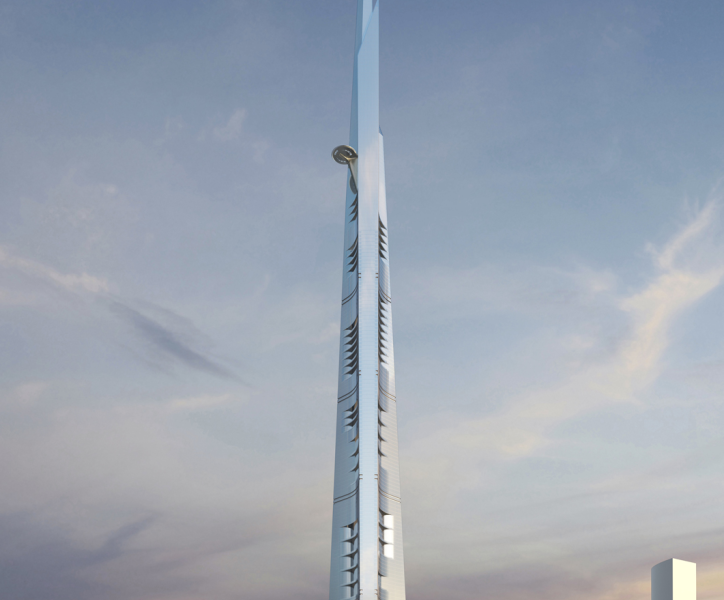
Jeddah Tower, the world’s tallest building-in-waiting, began construction overseven years ago.
The ambitious $1.4 billion project will be home to a mix of residential units, serviced apartments, and hotels, with a Four Seasons hotel set to open within.
The central core of the tower currently stands at level 60, and the walls are 248-metre high.
When completed, Jeddah Tower will stand at an estimated height of one kilometre, towering over the current world’s tallest building, Burj Khalifa.
The tower has been designed by Adrien Smith + Gordon Gill Architecture and covers a floor space of 243,866 square metres. It will also have the world’s highest observation deck, located 664 metres off the ground.
Despite the project facing setbacks, Jeddah Economic Company, the building developer, recently posted a video on its Twitter page promoting the tower as part of Saudi’s Vision 2030. The ambitious vision aims to reduce the country’s dependence on oil and modernize its economy.
Although there is still no completion date in sight, once Jeddah Tower is finished, it will undoubtedly be a marvel of modern engineering.
With its impressive height and luxury amenities, the tower will be a symbol of Saudi Arabia’s move towards a modern, diversified economy.



